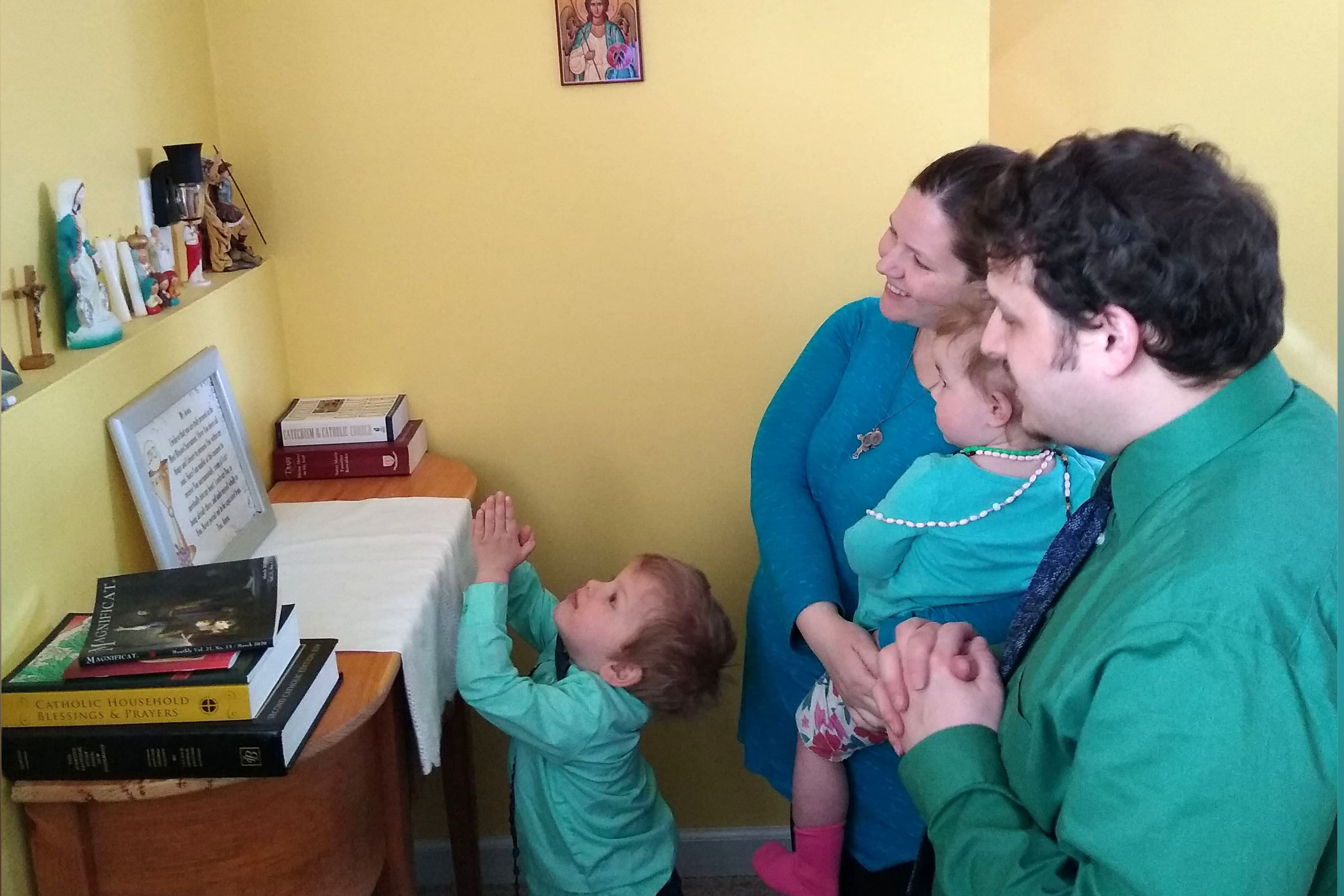Detroit-area Catholics adjust to life without Sunday Mass, regular access to the sacraments during coronavirus
STERLING HEIGHTS — Stephanie Leonardi still got dressed for Mass on Sunday.
She and her husband, Rob, got their two children up and ready. Everyone was in their Sunday attire, ready to join in the Eucharistic celebration.
Together as a family, they made their way to the living room of their Sterling Heights home, clearing out toys along the way, setting up the laptop and watching Detroit Archbishop Allen H. Vigneron celebrate Mass at the Cathedral of the Most Blessed Sacrament via livestream.
Leonardi wasn’t sure what she was expecting. Would it still feel like Mass? Would the stream buffer? How would her two children, ages 3 and 1, react to Mom and Dad watching a small screen in the living room?
But watching the Mass, Leonardi said was taken away by how much her children were involved, listening to the archbishop celebrate Mass on the first Sunday since the suspension of public celebrations of Mass because of the COVID-19 outbreak.
“I was honestly expecting our kids to not act very well. We were home, in our living room, toys around, so I wasn’t holding out hope for much,” Leonardi told Detroit Catholic. “As the Mass started, Archbishop Vigneron was singing the prayer, and my 3-year-old was watching, and my 1 1/2-year old was participating, acting like it was church. That really surprised me, gave me a sense of peace that it was going to be OK.”
News of the Mass cancellations in the Archdiocese of Detroit came on Friday, March 13, sparking a great deal of conversation about what it meant for Detroit-area Catholics. Parishes and the archdiocese scrambled to set up streaming options, and some Catholics, despite public health advice, traveled to neighboring dioceses of Toledo, Lansing or Saginaw (which have since suspended public Masses).
The Leonardi family set up a table Stephanie’s dad had gifted the couple, decorating it with a white cloth, a framed copy of the spiritual communion prayer and religious art they had around the house.


“We wanted to remind ourselves and the kids that even though we weren’t at Mass, it was still time with the Lord,” Leonardi said.
In Royal Oak, Stephanie Quesnelle and her husband, Jeffrey, made their way to the basement of their home with their daughter, Esther. The family opted to watch the first half of the Mass with Fr. Patrick Gonyeau at Corpus Christi Parish in Detroit before switching to Archbishop Vigneron at the cathedral — possibly the first instance of “channel surfing” when watching Mass, but such are strange times, Quesnelle said.
“Obviously, it was really hard to hear that we weren’t having Mass publicly available; I cried about it a lot,” Stephanie Quesnelle said. “I’ve traveled so much and was always able to find myself in a church with Mass on Sunday. I might not have understood the language, I might have been really out of place, like Mass in Cambodia with a Thai priest, barely speaking English, but we were still celebrating Mass. The idea on an average Sunday in Royal Oak that I wouldn’t be able to get Jesus in the Eucharist was just heartbreaking and so difficult.”
The Quesnelle family transformed their basement TV stand, setting up an altar with small statues and flowers around the television.
“You take for granted what you have,” Jeffrey Quesnelle said. “The only situation where you sort of envision that could be taken away is in some sort of post-apocalyptic world, where the Church is outlawed. You never thought it could be taken away from us in a developed first-world country, in an area that is culturally Catholic. But it goes to show how much all of us take the sacraments for granted, and how lucky we are to have it.”


The Leonardi family also did their best to sanctify their living room and made a point to stand and kneel during the livestream, doing their best to recreate the scene in their home.
“We removed a lot of clutter to keep the space less like our living room,” Leonardi said. “Our 3-year-old son knows all the responses to everything and made sure still to say those, following along, keeping it as close as possible to what we could do.”
The new normal
With public Masses suspended until April 6 and government officials speculating “social spacing” initiatives could last until July, Stephanie Quesnelle admitted part of the reason she chose to watch Archbishop Vigneron’s livestream was to hear firsthand from the chief shepherd about his decision.
“You could tell his heart was very heavy during this Mass, tearing up during certain points,” Quesnelle said. “You can tell this decision was so for hard for him. His heart was breaking for us, who couldn’t actually participate in the Eucharist with him.”
Jeffrey Quesnelle added the visual of the cathedral all but empty — except for Fr. J.J. Mech and Fr. Mario Amore concelebrating with the archbishop and seminarians from Sacred Heart Major Seminary serving Mass and a couple of cameramen from the Archdiocese of Detroit — was stark.

“It gave the feeling of being an underground church, that we were doing something countercultural,” Jeffrey said. “Even though you could say watching a stream online is convenient, it really felt almost like a radical thing we were doing in the midst of all the crazy things that are happening.”
For Catholics who couldn’t catch the online stream on Sunday, not having Mass available daily will be a challenge.
Tia Chase, a parishioner at St. Joseph Shrine in Detroit, lives with her mom, but Tia is the only one in the house who practices the faith, so Sunday is usually a day she is surrounded by fellow Catholics.
“I have a statue of Mary in my room and a Marian candle, so I just sat on my bed, praying the rosary,” Chase said. “There is a cross on the wall, so I used that as my space to pray because praying in my family isn’t normal.”
St. Joseph Shrine is still open for Eucharistic adoration — the parish has an online signup sheet to keep the numbers under 10. Chase said she will try to make it to the parish, but is relying on online resources to stay connected to the faith.
“I’ve been praying the rosary every day as part of my Lenten sacrifice” since the coronavirus outbreak, Chase said. “I started praying the Hour of Divine Mercy, 3 o’clock every day, depending on where I am. I try to pray and thank God for His mercy.
“I think this all helped me, in a very unusual way, learn not to take the Eucharist for granted,” Chase added. “There are a lot of countries where Catholics are suppressed or have to hide going to Mass all the time. But we have the church at our feet all the time. This helps me appreciate the faith more, growing in a relationship with the Lord, but hard it’s hard when you don’t know what’s going to happen next.”










